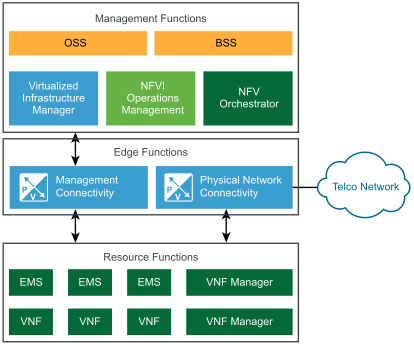Architecting vCloud NFV using well defined modules allows the CSP to accelerate deployment and reliably expand it when needed. The vCloud NFV components are grouped into three distinct containments.
- Management Functions. Management functions are required to manage the NFV Infrastructure and the Virtual Network Functions (VNFs). MANO components, FCAPS functionality and ancillary elements such as DNS and OSS/BSS are grouped into this category.
- Edge Functions. The edge functions provide a logical networking delineation between Virtual Network Functions and external networks. Network traffic transitioning between the physical domain and the virtual domain is processed by these functions. An example of such a function is NSX Edge Services Gateway (ESG).
- Resource Functions. The VNFs and functions related to VNFs, such as VNF Managers, are grouped into this category.

The three functions described above can be grouped into pods. Pods represent a functional and modular boundary that is well defined and therefore easy to replicate. Grouping the functions into three pods matches the design of the previous vCloud NFV reference architecture. In VMware vCloud NFV 2.0, an alternative design leveraging two pods is introduced.
Pods can be used to streamline the NFV environment operations and delineate between different roles. For example, a cloud management team can easily operate the Management pod while a network management team is likely to oversee the Edge pod. VNFs will always be deployed in the Resource pod.
Each pod is identified by its functional designation: Management pod, Edge pod, and Resource pod. The pod functions are:
- Management Pod. VIM components such as vCenter Server Appliance, NSX Manager, and vCloud Director are hosted in this pod. The plethora of FCAPS components, which include vRealize Operations Manager, vRealize Network Insight, vRealize Log Insight, Site Recovery Manager, vSphere Replication, and vSphere Data Protection are all found in this pod. Other management related components such as NFV Orchestrators run in the Management pod. OSS/BSS can be very large in sizing, which is why their placement is dependent on the system itself. Since OSS/BSS are essential for the management of the virtual network services, the Management pod is a natural location to install these.
- Edge Pod. As described in the Solution Overview section of this document, the virtual network NFVI building block is based on NSX for vSphere. NSX ESG, hosted in the form of a virtual machine appliance in this pod, handles all connectivity to the physical domain in the architecture. Other edge functions can also be hosted in this pod based on the operator needs. The type of networking traffic that traverses the Edge pod is referred to as North-South traffic.
- Resource Pod. Virtual Network Functions (VNFs) and their managers (VNFM) are placed in the Resource pod. The VNFs then form the virtual network service.
- Edge / Resource Pod. With this release, we introduce a new construct that combines the Edge pod and Resource pod functionality into a single collapsed pod. The Edge / Resource pod hosts both the service constructs (VNFs) and the networking components they need.
Using this collapsed pod function, two designs are possible: two-pod and three-pod. The two-pod design is described in detail in the Two-Pod Design Overview section of this document, while the three-pod design is covered in the Three-Pod Design Overview section. Guidance is provided on the use cases best fitting each of the designs in the Using Two-Pod or Three-Pod Design for vCloud NFV section of the document.